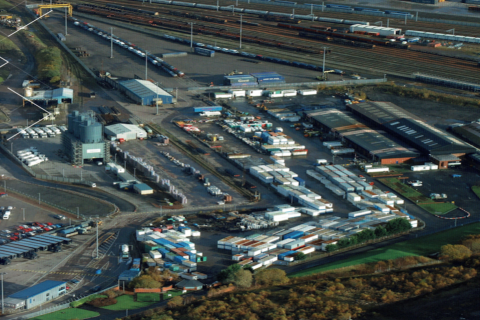EU rail freight test portal now live

The pilot version of a ‘one-stop-shop’ European web portal detailing rail freight service facilities across the continent can now be accessed online. The railfreightlocations.eu site is a European Union initiative involving a group of rail stakeholder partners, and focuses on the last-mile infrastructure.
It is being led by the Directorate-General for Mobility and Transport (DG Move), the section of the European Commission responsible for devising and delivering EU policy on mobility and transport.
The interactive portal contains information relating to all aspects of rail freight provision, including terminals, ports, maintenance and storage. It says the structure of the European rail freight market has ‘profoundly changed’ over the past decades, and that this situation is ‘particularly challenging’ for last-mile operations.
Last-mile infrastructure
“An easy and quick access to information about last-mile infrastructure for rail freight – specifically on rail freight access points – would improve service planning, in particular across borders,” it adds. “DG MOVE has therefore taken the step to support the market with a web-based portal offering a ‘user-friendly access to information on last-mile infrastructure for rail freight.”
Lead partners are the International Union of Railways (UIC) and the German-based logistics software developer HaCon, with support from the International Union for Road-Rail Combined Transport (UIRR) and IT providers Triona and IT Kreativa. They have developed an initial pilot portal and filled it with data from dedicated regions.
Among those who have provided operating data for the test site are the rail infrastructure managers for Greece, Macedonia, Serbia, along with rail freight operators DB Cargo, SBB Cargo and Green Cargo, and the International Rail Freight Business Association.
Rail Freight Corridors
The UIRR meanwhile has also been asked by the Slovak Ministry of Transport for help in leasing a newly-completed ‘open access’ intermodal terminal in the northern city of Žilina. Located at the heart of the European transport network, it links directly with two of the crucial Rail Freight Corridors): RFC9 Czech-Slovak, which stretches from Prague & Ostrava to Košice near the Slovakia/Ukraine border, and the more strategic RFC5 Baltic-Adriatic, which covers Slovakia, Austria, the Czech Republic, Italy, Slovenia and Poland.
In a statement, it said: “UIRR, as the industry association working for road-rail combined transport, is committed to facilitate and support any initiative that will advance the efficiency and productivity of rail freight and terminals, which are important factors of intermodality.
“UIRR expects that advertisements of this type will become more commonplace as the European Commissioning Implementing Act on Access to Service Facilities and Rail-related Services is nearing completion. This Act will aid the imposition of the recast First Railway Package into Member State law from the perspective of service facilities, which include intermodal terminals.
Modal shift
“In order to deliver the the modal shift foreseen in the 2011 EU Transport White Paper as indispensable to limit the carbon footprint of the transport sector – 30 per cent of road-tonne kilometres realised on distances of 300km or more by 2030, and 50 per cent by 2050 – many more state-of-the-art terminals such as the one in Žilina will have to be built and placed into service.”
You just read one of our premium articles free of charge
Want full access? Take advantage of our exclusive offer






